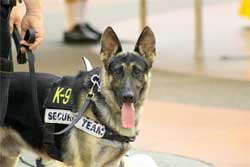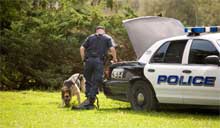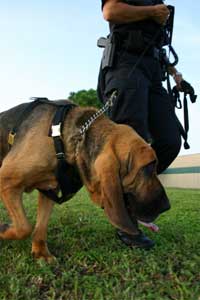"He is your friend, your partner, your defender, your dog. You are his life, his love, his leader. He will be yours, faithful and true, to the last beat of his heart. You owe it to him to be worthy of such devotion"
Unknown
|
 Super Cops: A police dog is a dog that is trained specifically to assist police and similar law-enforcement personnel with their work. They are also known in the United States as police K9s (a play on words; a homophone for canine). Super Cops: A police dog is a dog that is trained specifically to assist police and similar law-enforcement personnel with their work. They are also known in the United States as police K9s (a play on words; a homophone for canine).
The term is sometimes used in the common parlance of several countries to refer to any German Shepherd Dog because of the long history of the use of the German Shepherd by the police and military; in some nations German Shepherds are the only dogs used by those forces. In the post-industrial era German Shepherds have often been depicted as police dogs in television, movies and police dog memorials. This breed is often still used, as are a few other breeds. Almost all dog breeds that are trained for police work, originate from Germanic and Romance countries.
 FREEZE!: Most often, "police dog" refers to a dog who has been trained to guard their handler, and to find, chase, intimidate, and hold suspects who are attempting to elude the police. Modern police dogs are not vicious animals; most are trained to enjoy their work, with chasing and grabbing introduced to them as tricks or games that can be played only when the handler (a police officer) gives the appropriate command. The dog's goal is not to bite; it is to grab and hold on at all costs until the handler gives the release command. This means that the dog grabs hard, and a fleeing suspect can be bitten when attempting to avoid or fight off a dog and the dog is attempting with full speed and energy to grab the suspect. Most handlers, if possible, give the suspect a verbal warning that the dog will be set loose if they do not immediately halt, and this is often sufficient deterrent that the dog is not needed. FREEZE!: Most often, "police dog" refers to a dog who has been trained to guard their handler, and to find, chase, intimidate, and hold suspects who are attempting to elude the police. Modern police dogs are not vicious animals; most are trained to enjoy their work, with chasing and grabbing introduced to them as tricks or games that can be played only when the handler (a police officer) gives the appropriate command. The dog's goal is not to bite; it is to grab and hold on at all costs until the handler gives the release command. This means that the dog grabs hard, and a fleeing suspect can be bitten when attempting to avoid or fight off a dog and the dog is attempting with full speed and energy to grab the suspect. Most handlers, if possible, give the suspect a verbal warning that the dog will be set loose if they do not immediately halt, and this is often sufficient deterrent that the dog is not needed.
Some police dog units prefer to start with a pursue and bark tactic, where the dog barks to alert the handler to his whereabouts and to intimidate the suspect and keep him from running until the police arrive. In this case, the dog usually grabs and holds only when the suspect does not halt. Others feel that the bark first, bite later strategy is not effective and prefer to always use the chase and hold strategy.
 Family Pets: Most of these dogs live in their handlers' homes and interact with their family and friends on a regular basis to ensure that they remain social and pleasant animals. Family Pets: Most of these dogs live in their handlers' homes and interact with their family and friends on a regular basis to ensure that they remain social and pleasant animals.
A police dog and handler train and work as a team, because they must trust each other and understand each other completely when working in stressful, even dangerous, and often rapidly changing situations. Police dog teams have been accused of using excessive force in some cases, so it is critical that the human be able to manage a difficult situation wisely, to use the trained dog only as appropriate, and to be able to control the dog completely so that the dog can be called off instantly when the situation warrants.
Dog Security: In recognition of the valuable role these animals play in police duties and the dangers they face, there have been a number of measures to ensure their protection. These include outfitting dogs with bulletproof vests to protect them from guns and some areas have passed laws that make attacking a police dog a felony. In some jurisdictions police dogs are considered to be police officers in law so that any penalty that can be applied to the assault of a human police officer can also apply to an assault on a police dog.
All text is available under the terms of the GNU Free Documentation License |
